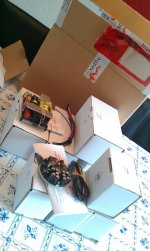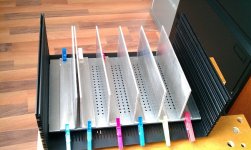View attachment frekvens uden filter .bmp
I think I have some off the worlds best speakers. This is the midrange .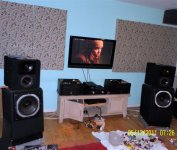
My references are the best.
I think I have some off the worlds best speakers. This is the midrange .

My references are the best.
Thanks for that clear response.
Well yes, sorry for the bad news. I know the advantages of current drive quite well (use it on the LS1) but the problem is that such a product would nevertheless be for a minority of savvy speaker designers. I think at this point the DIY spirit will have to kick in - I mean that some people might build a current feedback loop to wrap around a UcD/Ncore amp instead of waiting for the same guy to solve all problems
6moons heard both. Their verdict can be read between the lines. I'm sure Erland would be able to propose an improved power supply for the Devialet though.
Internal Layout
I thought I ought to document my observations on the build and sound of my nCores.
In summary, internal layout can be very important.
I received them back in the March delivery. Whilst tempted by the thought of simply fixing them to a piece of chipboard, spread out electronics and exposed mains wasn't going to be acceptable, so they had to be fitted into cases.
I'd bought a couple of cases in Jan last year (2011) ready to build some UcD400HG HXR monoblocks but had never ended up building (or buying) them - and once I'd heard about the nCores decided to wait for them. to be available Having seen the final design of the nCores I'd decided they needed a custom case but for the initial build I'd use the cases I'd already got.
The cases are a tight fit for the SMPS600 - they were intended for the SMPS400 - but everything fits in neatly. A bit of origami is needed to get everthing in place, but it's a neat fit. The cases are Uniobox 3 from Panel Print Panel Print - UnioBox and U-Case electronic enclosures and were chosen for being reasonably economical and neat. The size was chosen to accommodate the UcD modules and so that they can fit on the base plate of the stands for my standmount speakers. The SMPS is mounted to the bottom panel and the ncore to the top panel.
Having drilled all the casework the amps were powered up and checked at every stage of assembly - all components spread out to begin with, then rechecking them as each panel was completed. Assembly testing was done using a small pair of satellite speakers, a couple of lengths of bell wire and my galaxy S2 to stream flacs from my network server as a music source.
First proper listening was with the various parts all spread out under the speakers, without the boxes assembled. Sounded good. Assembled each box and started listening
Did lots of listening
Good but not good enough
(but please, dear reader, do read on)
Certainly not the 'amplifiers getting out of the way' and 'instruments hanging in space' comments and reviews seen here and (for example) on audiocircle.
Most systems do 'simple' reasonably well - they struggle when it gets complicated, and often 'complicated' is no more than the presence of sibliance or cymbals. My reference is live music - standing in (good amateur) chamber choirs and standing behind orchestras (singing) - way closer than a seat in the audience - including various regular recordings and performances for BBC radio and in a wide variety of venues. In real life 'complex' can be really loud and yet you can still discriminate different instruments and listen to a gong or brass band 2m away from you (or another singer next to your ear) without any sense of glass shatering treble distortion.
What was better?
Way less treble distortion, easier to pick out and follow the line of an individual instument - did complex much better; did simple much much better.
Effortless dynamics - much easier to play louder demanded to be played louder
demanded to be played louder 
A definite (and unsurprising) advance on their predecessor (don't ask, not particularly relevant, but certainly not esoteric high-end)
It's got me listening to more vinyl again
So what was wrong?
More sibilance than I expected (my bete noir); occasional 'shouty' treble
but mostly no sense of space around the instruments; when it got complicated, a sense of the instruments occupying a block of sound between the speakers rather than any separation.
Certainly not the sense of 'the amps getting out of the way'.
Spent a week wondering if I'd spent my money and time in the right way.
I was listening to music, lots of music, and enjoying it more, but it wasn't at the level I was expecting. And I know there are probably loads of you shouting 'source' or 'speakers', but to a certain extent the imaging and space were a backward step. Whilst trying to sort out the system I did lots of playing with speaker and furniture positions and in the process I learnt a lot more about their effect in my room, but I couldn't get the changes I was after
If your observations don't match those of others it's worth understanding why.
So, on the basis that they have received great reports when the modules have just been thrown together, I pulled the boxes apart and spread the components out over the floor
That's more like it
I've deliberately been a bit lazy with the wiring harnesses. I've always intended that the modules will go into new cases. I don't know what harness lengths the new cases will need so I've left the wiring in the current cases at their original length - they haven't been shortented to fit (Jan-Peter, can you make an optional wiring kit avaialble so we can readily buy the bits for rewiring). In a compact case the cables therefore need guiding and laying in place as the case is assembled. I've probably got about 100mm of internal speaker cable - twisted as instructed - but when the case is assembled the terminals on the amp are probably only about 50mm away from the ends of the case terminals. All the cable has to go somewhere.
I think it's worth drawing attention to Bruno's comment in section 7.1 of the manual -
The distortion of the NC400 is so low that it is easily exceeded by magnetic coupling between the supply wiring and the audio wiring
In this case(!) as I assembled the panels together I'd ended up with the speaker cables forming a big single turn helix between the ncore and the back of the speaker case terminals, and I'd effectively got the input cable looping round the ncore module. So I tried some rearrangement of the internal cables before reassembling the cases. The speaker cables now follow a sort of 'omega' shape, directed away from the psu cables and the input cables follow an 'S', they're folded backwards and forwards instead of wrapping round the ncore. It's not the way it would be done in the final cases - I'd intend the cables would be fitted and assembled in situ. Sound is improved form where it was, but I don't think as good as when the cases are disassembled.
So new cases being designed, and looking at what changes I intend to make upstream (and downstream). The amps were always intended as my next stepping stone for the rest of the system.
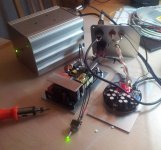
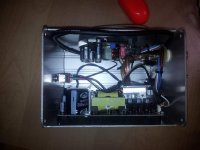
I thought I ought to document my observations on the build and sound of my nCores.
In summary, internal layout can be very important.
I received them back in the March delivery. Whilst tempted by the thought of simply fixing them to a piece of chipboard, spread out electronics and exposed mains wasn't going to be acceptable, so they had to be fitted into cases.
I'd bought a couple of cases in Jan last year (2011) ready to build some UcD400HG HXR monoblocks but had never ended up building (or buying) them - and once I'd heard about the nCores decided to wait for them. to be available Having seen the final design of the nCores I'd decided they needed a custom case but for the initial build I'd use the cases I'd already got.
The cases are a tight fit for the SMPS600 - they were intended for the SMPS400 - but everything fits in neatly. A bit of origami is needed to get everthing in place, but it's a neat fit. The cases are Uniobox 3 from Panel Print Panel Print - UnioBox and U-Case electronic enclosures and were chosen for being reasonably economical and neat. The size was chosen to accommodate the UcD modules and so that they can fit on the base plate of the stands for my standmount speakers. The SMPS is mounted to the bottom panel and the ncore to the top panel.
Having drilled all the casework the amps were powered up and checked at every stage of assembly - all components spread out to begin with, then rechecking them as each panel was completed. Assembly testing was done using a small pair of satellite speakers, a couple of lengths of bell wire and my galaxy S2 to stream flacs from my network server as a music source.
First proper listening was with the various parts all spread out under the speakers, without the boxes assembled. Sounded good. Assembled each box and started listening
Did lots of listening
Good but not good enough
(but please, dear reader, do read on)
Certainly not the 'amplifiers getting out of the way' and 'instruments hanging in space' comments and reviews seen here and (for example) on audiocircle.
Most systems do 'simple' reasonably well - they struggle when it gets complicated, and often 'complicated' is no more than the presence of sibliance or cymbals. My reference is live music - standing in (good amateur) chamber choirs and standing behind orchestras (singing) - way closer than a seat in the audience - including various regular recordings and performances for BBC radio and in a wide variety of venues. In real life 'complex' can be really loud and yet you can still discriminate different instruments and listen to a gong or brass band 2m away from you (or another singer next to your ear) without any sense of glass shatering treble distortion.
What was better?
Way less treble distortion, easier to pick out and follow the line of an individual instument - did complex much better; did simple much much better.
Effortless dynamics - much easier to play louder
A definite (and unsurprising) advance on their predecessor (don't ask, not particularly relevant, but certainly not esoteric high-end)
It's got me listening to more vinyl again
So what was wrong?
More sibilance than I expected (my bete noir); occasional 'shouty' treble
but mostly no sense of space around the instruments; when it got complicated, a sense of the instruments occupying a block of sound between the speakers rather than any separation.
Certainly not the sense of 'the amps getting out of the way'.
Spent a week wondering if I'd spent my money and time in the right way.
I was listening to music, lots of music, and enjoying it more, but it wasn't at the level I was expecting. And I know there are probably loads of you shouting 'source' or 'speakers', but to a certain extent the imaging and space were a backward step. Whilst trying to sort out the system I did lots of playing with speaker and furniture positions and in the process I learnt a lot more about their effect in my room, but I couldn't get the changes I was after
If your observations don't match those of others it's worth understanding why.
So, on the basis that they have received great reports when the modules have just been thrown together, I pulled the boxes apart and spread the components out over the floor
That's more like it
I've deliberately been a bit lazy with the wiring harnesses. I've always intended that the modules will go into new cases. I don't know what harness lengths the new cases will need so I've left the wiring in the current cases at their original length - they haven't been shortented to fit (Jan-Peter, can you make an optional wiring kit avaialble so we can readily buy the bits for rewiring). In a compact case the cables therefore need guiding and laying in place as the case is assembled. I've probably got about 100mm of internal speaker cable - twisted as instructed - but when the case is assembled the terminals on the amp are probably only about 50mm away from the ends of the case terminals. All the cable has to go somewhere.
I think it's worth drawing attention to Bruno's comment in section 7.1 of the manual -
The distortion of the NC400 is so low that it is easily exceeded by magnetic coupling between the supply wiring and the audio wiring
In this case(!) as I assembled the panels together I'd ended up with the speaker cables forming a big single turn helix between the ncore and the back of the speaker case terminals, and I'd effectively got the input cable looping round the ncore module. So I tried some rearrangement of the internal cables before reassembling the cases. The speaker cables now follow a sort of 'omega' shape, directed away from the psu cables and the input cables follow an 'S', they're folded backwards and forwards instead of wrapping round the ncore. It's not the way it would be done in the final cases - I'd intend the cables would be fitted and assembled in situ. Sound is improved form where it was, but I don't think as good as when the cases are disassembled.
So new cases being designed, and looking at what changes I intend to make upstream (and downstream). The amps were always intended as my next stepping stone for the rest of the system.


Yes! Received my order today! I can start with my multichannel (5) amp!
Good luck in building your amp! What type of chassis did you buy?
Good luck in building your amp! What type of chassis did you buy?
It's a Modu Slimline 4 u with extra chassis piece.
Jan, I was referring to the measurements given in the THD vs. power charts on the Hypex nc1200 datasheet (page 9 of http://www.hypex.nl/docs/NC1200_datasheet.pdf), where 1% distortion occurs at roughly 350 watts at 8 Ohms at 100Hz. If the module has changed since then, that's great. I am *nitpicking in the extreme* here......When reviewing the measurements on the 1200 I can confirm the fantastic specs like the mentioned 0.003% at all powers and all frequencies.
Yes and that's seen in the other measurements. It's so cool to see the THD vs. freq line drop...just impossible in any non-class-D that I can envision. I still can't believe Bruno found a way to create a self-oscillating amp with *such* low distortion...Bruno, did you always think you could get it there? BTW Jan you have a great website, I never looked before, though I've heard much about your work.Can you believe an output impedance of around 1milliohms, and that from DC to above 20kHz?? What jumps out immediately is that this amp doesn't have the rise in THD, rise in Zout and fall in PSRR that a 'regular' amp would show above a few kHz at best...
...There are more paradigm shifts: the 5kHz THD is LOWER than the 1kHz THD, for instance. Which is great as it does lower the higher harmonics even further.
There is a great recording, Reference Recordings' All Star Percussion Ensemble (GS DXD 002), where on the world's best systems you can hear the performers breathing, turning pages, and putting down mallets onto cloth. In the final assemblies our now-extinct company made, where we used the older redbook version of that CD, we only listened for the unwanted noise in recordings, the wanted signal was "all there." I expect with the Hypex and Mola Mola gear even better resolution happens. I really would like to try a mastering version of the B&Ws, one with an external digital crossover (DLCP) and an ncore amp for each driver...Bruno confidently maintains that this kind of performance is not offered by ANY amp on the market today, not even class A.
But, the proof is in the eating of course so the 2nd part of the presentation was a listening test with Bruno's LS1 active speakers driven by ncore modules. Not a scientifically controlled listening test, but most of those present make their living by listening and judging music and they were impressed, as was I. Some people said they recognised the acoustics of the studio where some of the tracks were produced...
Yves, I assume you had the same source for each, the variable XLR output of the Accuphase?OK, Chiming in
802 Diamonds are driven pretty well by UCD400HG. I took a dual mono, 2x SMPS400 + 2xUCD400HG+HxR to the dealer to listen to them before I bought. Dealer didn't have a balanced pre-amp at hand, so we connected my amp straight to the variable XLR out from an accuphase CD player (don't remember which one)
My comparisons were with a Devialet hybrid class A/D Amp... ...The devialet is the machine I'll use as a reference.
What's a Farad between friends?6moons heard both. Their verdict can be read between the lines. I'm sure Erland would be able to propose an improved power supply for the Devialet though.
That's good, but one dealer we (sadly) shared with at a show decided to loosen the screws on a set of Audio Physik TWEETERS. Well it probably *didn't* hurt because AP used a fat rubber O-ring to seal the stupid things. Of course after we fixed the sound at their absence by undoing their 30-deg toe-in, they promptly re-ruined the setup. All but a little toe-in is usually a bad idea, in spite of what most builders say. IMHO. OK enough screwing around...Thanks 6moons for the laugh of the day. No need for stomach exercises today!
Chris, were those photos of the corrected layout? Wires ought to be twisted *tight*. You can drop a length in half easily with enough twist. But why not just trim the wires?I thought I ought to document my observations on the build and sound of my nCores.
In summary, internal layout can be very important. In a compact case the cables therefore need guiding and laying in place as the case is assembled. I've probably got about 100mm of internal speaker cable - twisted as instructed - but when the case is assembled the terminals on the amp are probably only about 50mm away from the ends of the case terminals. All the cable has to go somewhere.
I think it's worth drawing attention to Bruno's comment in section 7.1 of the manual -
The distortion of the NC400 is so low that it is easily exceeded by magnetic coupling between the supply wiring and the audio wiring...
Others (Julf?) have said that you can place various parts very closely without measurable effect. But I would really want to keep the PS in front and the ncore in back, keeping the input and output leads ultra-short. The AC line could be shielded on its way to the PS. Just random thoughts.
Your cases look good and are aluminum. If anyone uses steel cases they should keep the wires and all parts away from the steel. Better yet, don't get steel.
I know, I should just buy and build some ncores and shut up.
Last edited:
Well yes, sorry for the bad news. I know the advantages of current drive quite well (use it on the LS1) but the problem is that such a product would nevertheless be for a minority of savvy speaker designers. I think at this point the DIY spirit will have to kick in - I mean that some people might build a current feedback loop to wrap around a UcD/Ncore amp instead of waiting for the same guy to solve all problems
Did you use current drive on the tweeter, or woofer or both on the LS1?
Can you estimate the reduction is distortion achieved?
Acording to the LS1 white paper:
The power amplifiers are UcD180 modules, slightly
modified. Their frequency-independent distortion and
extremely low output impedance minimizes their sonic
footprint, a trait that has earned these amplifiers a following
in mastering studios.
Chris, were those photos of the corrected layout? Wires ought to be twisted *tight*. You can drop a length in half easily with enough twist. But why not just trim the wires?
Others (Julf?) have said that you can place various parts very closely without measurable effect. But I would really want to keep the PS in front and the ncore in back, keeping the input and output leads ultra-short. The AC line could be shielded on its way to the PS. Just random thoughts.
Your cases look good and are aluminum. If anyone uses steel cases they should keep the wires and all parts away from the steel. Better yet, don't get steel.
I know, I should just buy and build some ncores and shut up.
No, they're photos of the original layout. Effectively the bit of speaker cable you can see is the side of the single-turn helix. They are twisted as tightly as the stupidly thick bit of speaker cable off-cut I used would allow. I haven't taken photos of the rearranged cable routing.
As I said in my original post, the underlying reason was convenience and ease of assembly. These cases were intended to be a comparatively temporary neater/safer alternative to a piece of chipboard. And as the cases are a bit of a 3D jigsaw, it was a comnination of leaving the Hypex harnesses untouched and ease of assembly (of the speaker cables) while the cases were apart. Unfortunately the sound quality ended up lower than a piece of chipboard (maybe it's because there's not enough wood in the case................
Well yes, sorry for the bad news. I know the advantages of current drive quite well (use it on the LS1) but the problem is that such a product would nevertheless be for a minority of savvy speaker designers. I think at this point the DIY spirit will have to kick in - I mean that some people might build a current feedback loop to wrap around a UcD/Ncore amp instead of waiting for the same guy to solve all problems
But it's so nice when it has been done by someone who really knows what he/she's doing
I would find it awesome if someone published a DIY guide on how to do that, so that even I who don't know circuit design but likes to build stuff can have a go at it
...But it's so nice when it has been done by someone who really knows what he/she's doing...
+1 for the "who really knows what he/she's doing
Acording to the LS1 white paper:
The statement of low output impedance would imply voltage driving, not current driving.
Indeed, that is why I quoted it. It might have changed in the prototype Bruno is currently using though.
I think current drive is a really important matter, as it address some sort of distortion in the driver itself. It is an incredible and somewhat overlooked tool for the DIY speaker builders that many of us here are.
I think current drive is a really important matter, as it address some sort of distortion in the driver itself. It is an incredible and somewhat overlooked tool for the DIY speaker builders that many of us here are.
I think current drive is a really important matter, as it address some sort of distortion in the driver itself. It is an incredible and somewhat overlooked tool for the DIY speaker builders that many of us here are.
While it isn't a magic silver bullet, it is definitely a valuable technique if you are designing your speakers from scratch. Doesn't really help those of us who are working with existing designs.
Nelson Pass has a paper of his website about the benefit of current driver (mainly regarding frequency response...) with fullrange drivers.
When multi amplifying drivers that operate in narrow ranges (above their resonance frequency and under their impedance rise) current drive amplifier can be used without any modification.
I think if this technique was more common we would see more drivers and even complete speakers designed for current drive amplifier. But this has to start somewhere, and these forums are the ideal place for that as it has both amplifiers and loudspeakers DIY sections!
When multi amplifying drivers that operate in narrow ranges (above their resonance frequency and under their impedance rise) current drive amplifier can be used without any modification.
I think if this technique was more common we would see more drivers and even complete speakers designed for current drive amplifier. But this has to start somewhere, and these forums are the ideal place for that as it has both amplifiers and loudspeakers DIY sections!
The statement of low output impedance would imply voltage driving, not current driving.
having a hi-z amp is not the only way to implement current drive in a system.
Alan Garren
Yetis, I would refer you to look at Figure 2 on page 12 of the NC400 data sheet. The preferred connection is for NAMPON (and XLR pin 1) to be tied to chassis ground. On my NC400's I wired NAMPON directly to XLR pin 1 as I don't have mine in chassis yet and they worked flawlessly. Good luck.
So I got one of them to work and well I might add. Now I am really flustered. This as I have one that works and one that does not. They are wired identically. I have a circuit tester and all the grounds, xlr connections, etc all seem to work the same, yet one works and one doesn't. There was never any "issues" when I was working the units. They both just simply click, when I plug them in -- with one working. The thought of breaking them both down and swapping the amps to isolate the issue, isn't high on my list. Any suggestions?
thanks
Thanks
- Status
- Not open for further replies.
- Home
- Amplifiers
- Class D
- Hypex Ncore
